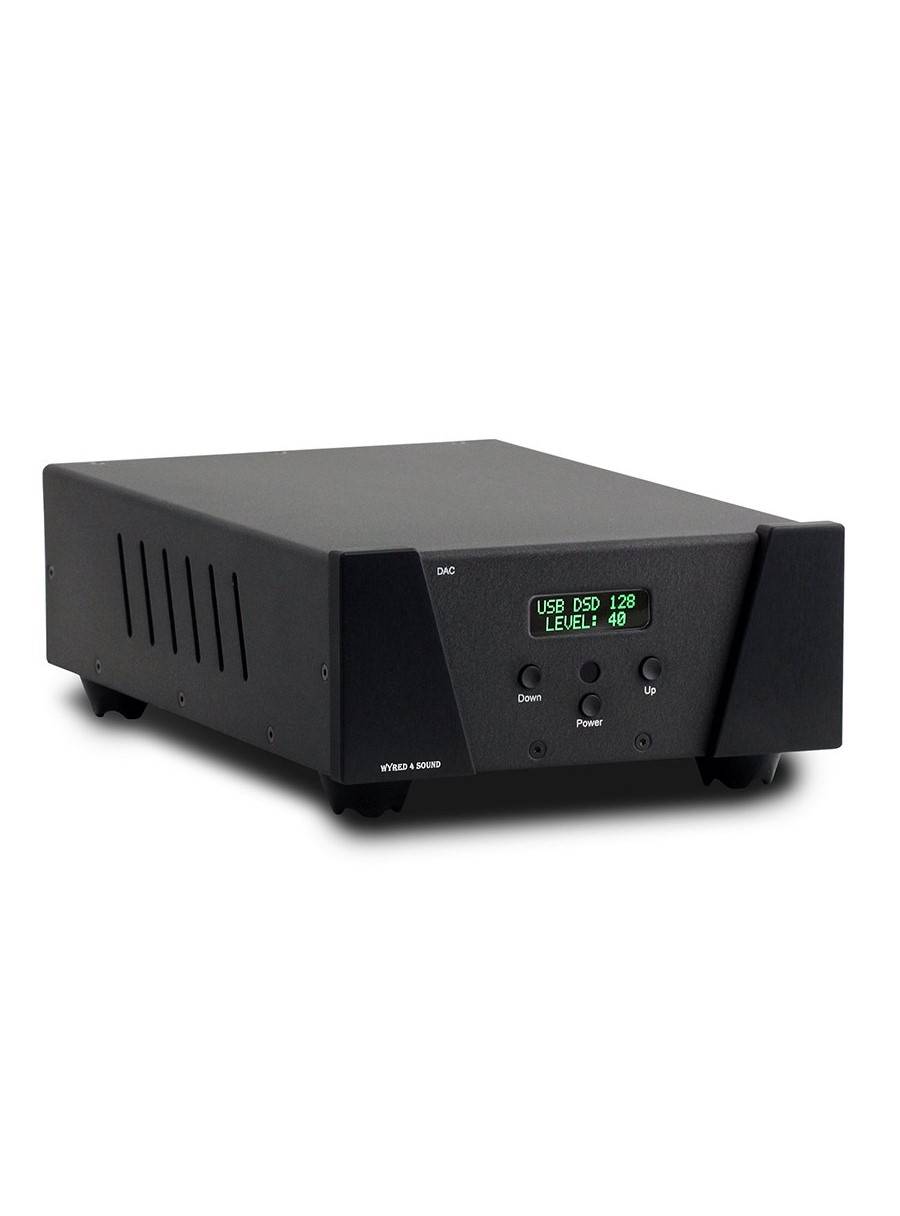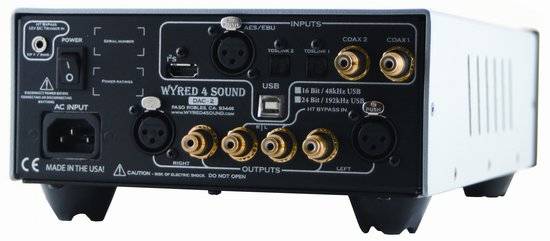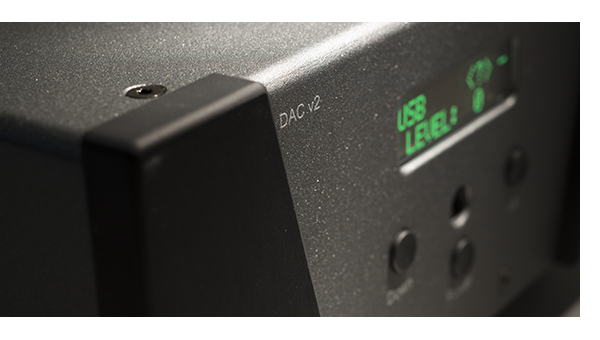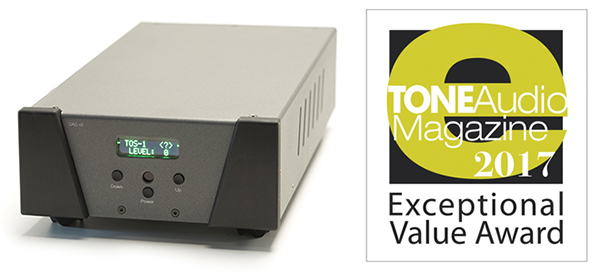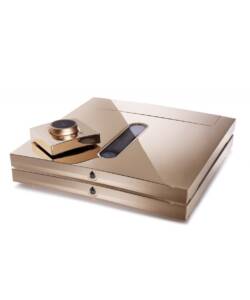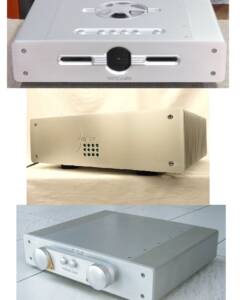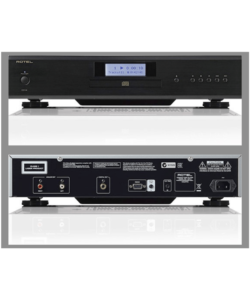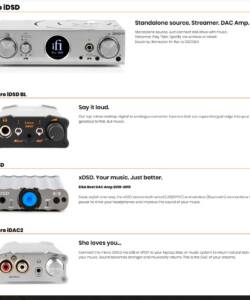Wyred 4 Sound DAC 2v2 SE (Latest $3900 model)
Original price was: R98,000.00.R29,900.00Current price is: R29,900.00.
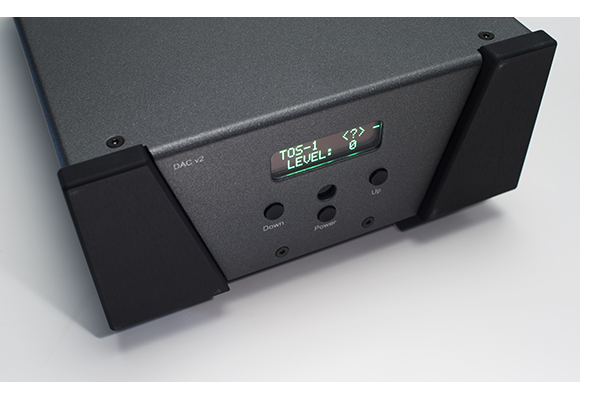 Based in California, E.J. Sarmento founded Wyred 4 Sound in 2007 with a goal of producing stellar audio components at prices within financial reach of many music fans. In the decade since the release of their first amplifier, their product line has grown substantially, now including preamplifiers, music streamers, integrated amplifiers, cables, audio accessories, and more.
Based in California, E.J. Sarmento founded Wyred 4 Sound in 2007 with a goal of producing stellar audio components at prices within financial reach of many music fans. In the decade since the release of their first amplifier, their product line has grown substantially, now including preamplifiers, music streamers, integrated amplifiers, cables, audio accessories, and more.
Of course, they have also invested significant engineering time honing their digital components like the DAC-2v2 and the DAC-2v2SE (the subject of this review). To commemorate their 10th anniversary this year, a limited production 10thanniversary DAC-2v2SE was also released. Since the beginning, Wyred 4 Sound’s gear is designed and built in the United States, and they sell their products directly to the public from their headquarters. Because their production facility remains onsite as well, in the unlikely event a product should fail, a customer can also work directly with Wyred’s team in California to quickly resolve the issue.
Standard versus Special Edition
As suggested by the name, the DAC-2v2 builds upon the sonics of the previous iteration in many ways. First, the DAC chip upgrades to the ESS Sabre 9028PRO. The green OLED display is not on the 2v2, it is exclusive to the 2v2SE.
The SE version takes things even further with the ESS flagship Sabre 9038PRO DAC. It also offers several internal component upgrades including Schottky diodes and higher-grade fuses supplementing custom capacitors and Vishay Z-Foil resistors. The SE also features an upgraded Femto-grade clock, offering greater precision, corraling the digital bits into an optimal stream, reducing jitter significantly. It also has a green OLED display, which Wyred says is quieter than the regular blue LED display of the default DAC-2v2.
Hefty build
Weighing in at 14 pounds, the small 8.5″W x 4.125″H x 13.5″D enclosure packs much goodness under the hood, combining minimalist aesthetics, with densely packed internals. A deep grey powder-coated surface provides the DAC with a subtle matte finish (black also available), interrupted only on the sides by angled ventilation holes – a W4S trademark. Two black-anodized accent sections placed on the front panel offer some spice to the edges of an otherwise boxy form factor. Between them, a narrow OLED display is flanked by small “up” and “down” buttons on the sides, and a standby power button underneath. In addition to controlling volume, these buttons double as menu navigation tools during DAC setup. For those who prefer making adjustments from the comfort of their listening seat, an included remote control allows changes on the fly.
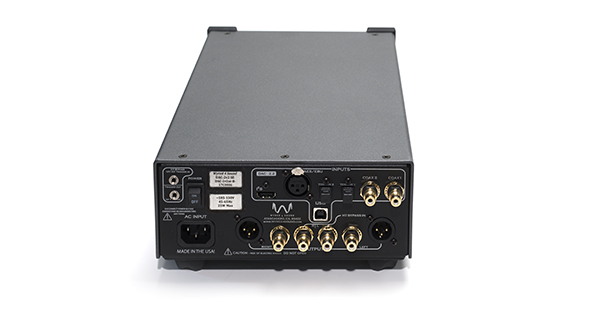 The rear panel offers all the digital ins and analog outs one might need. Outputs accommodate both balanced and single ended connections. Input options include USB, Toslink, Coaxial, AES/EBU, and HDMI connections. With all these options at the ready, it is a breeze to connect any digital source to the DAC and get the music up and running. A 12-volt trigger and home theater bypass capability offer additional flexibility in a larger home entertainment setup.
The rear panel offers all the digital ins and analog outs one might need. Outputs accommodate both balanced and single ended connections. Input options include USB, Toslink, Coaxial, AES/EBU, and HDMI connections. With all these options at the ready, it is a breeze to connect any digital source to the DAC and get the music up and running. A 12-volt trigger and home theater bypass capability offer additional flexibility in a larger home entertainment setup.
Depending on the source material, the unit’s internals can process 32-bit files up to a sample rate of 384 kHz PCM and native DSD files up to DSD256.
Fine Tuning
The DAC 2v2 series offers a few menu items not available previously, including multiple jitter reduction adjustments. Wyred 4 Sound recommends the lowest possible jitter setting for ideal sonic performance. However, that setting does place an additional performance tax on the component. Wyred suggests trying the lowest setting, and edging up from there among the five remaining increments if needed. Following their suggestions, the lowest setting never introduced any stutter in the system, but the sound did become a bit more relaxed and smooth with the jitter-reducer working its magic.
Another handy feature on both the DAC 2v2 standard and SE DAC versions is the variable output. If connecting the DAC to a preamplifier through RCA or XLR interconnects, the DAC allows the user to override its internal volume controls in favor of letting the preamp take on that role. However, for those who listen to digital music only, the DAC allows the user to connect it directly to an amplifier, using the built-in variable output as the system volume control.
Increasing the flexibility of the DAC, Wyred also builds into the menu options seven different digital filters. The DAC owner can experiment with all the options to determine the one that he or she prefers. For those in doubt, the DAC2v2 manual suggests starting with the “Apodizing fast rolloff, linear phase” option, and the small tweak does offer fantastic sound.
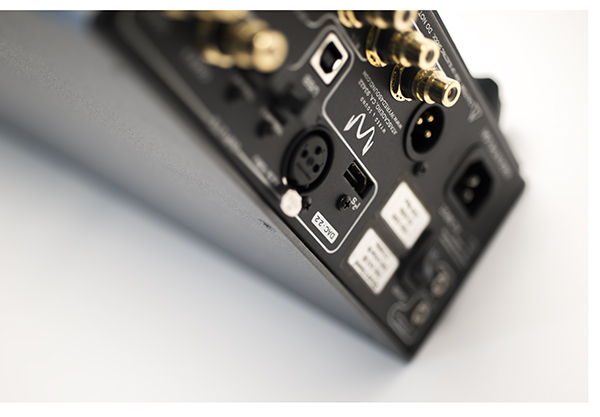 If connecting your DAC to a computer via USB, note that both Mac and Linux-based systems have native support. Plugging the DAC into a Mac Mini offered not a single hiccup. The computer recognized it immediately through the Roon interface, providing music in a few minutes. For those with Windows-based systems, a required driver is available from the Wyred 4 Sound website.
If connecting your DAC to a computer via USB, note that both Mac and Linux-based systems have native support. Plugging the DAC into a Mac Mini offered not a single hiccup. The computer recognized it immediately through the Roon interface, providing music in a few minutes. For those with Windows-based systems, a required driver is available from the Wyred 4 Sound website.
Wyred 4 Sound suggests 200 hours of break in time for the DAC, and with several days under its belt, it certainly demonstrated its prowess. For the majority of our testing, the DAC 2v2SE was connected directly to an amplifier, using the variable volume control feature. Reducing the number of components and interconnects gives this DAC the straightest possible signal path between source and speakers. While the digital filters do offer minor variances to the DAC’s overall sound, the Wyred has a general sound signature at its heart. At first listen, the DAC 2v2SE demonstrates a natural, and relaxed presentation. There’s a slight warmth complementing a high level of detail retrieval. Those seeking a DAC that exposes every bit of detail, including of glare or stridency inherent in a recording, may prefer more stark voicing. However, potential owners wishing for a more analog-like interpretation in their audio system will welcome the 2v2SE’s ability to file down the sharp edges ever so slightly in the name of musicality.
Extensive soundstage portrayal is DAC 2v2SEs top strengths. Musical cues extended to the far left, right and rear of the speakers’ imaging limits give a convincing and layered presentation. Listening to albums like Silent Letters from Bliss, the rich soundstage created by the engineers demonstrates the DAC 2v2SE’s ability to ingest, process and share out the digital bits with aplomb, re-creating the subtle details contained within. Cymbal crashes generate a complexity of audio frequency transmissions, offering a solid approximation as if sitting several rows back in an auditorium at a live concert. Similarly, the woodiness of clarinets and the brassiness of trumpets roll forth as dictated by the quality of a given recording.
Both male and female voices are rendered with a natural quality. In the absence of sharp edges to the sound make the DAC 2v2SE a great friend for long listening sessions. Ear fatigue never enters into the equation, giving the listener a chance to settle into the music for the long haul.
Bass-wise, the 2v2SE maintains a solid grip on bass without mushiness or disappointment in impact. The balance of bass with the rest of the audio spectrum does not tilt in favor of low-frequency information through this DAC. Those with a powerful solid-state amp are likely to find the partnership between the two components a welcome fit. Potential owners with tube amplifiers like the Conrad-Johnson Classic Sixty-Two we had on hand for testing, will be delighted equally. The DAC 2v2SE does not appear to modify the sound of any amp it is mated with, it just gives the amp a chance to sing to its full potential.
This base DAC-2v2 retails for $2,299, and the even more advanced SE edition in this review retails for $3,799. While we did not have the opportunity to compare-and-contrast the standard edition to the SE version, the SE version performs very well at its price point. This DAC combines excellent build quality, understated modern looks, and a confidence inspiring five-year warranty. Wyred 4 Sound also provides a generous trade-in program to those who own older DACs and wish to upgrade to these latest iterations.
Considering many high-end DACs today cost well over $10k, and the marvelous quality of Wyred’s DAC represents a substantial value. Yes, more money can buy a higher degree of refinement and realism. However, the Wyred delivers a lot of prowess for its price point. Because of the variable output capability, this DAC can also function effectively as a preamplifier. For those listening only to digital music, it is a bit like getting two products for the price of one. Additionally, for those who enjoy fine-tuning their DAC’s sound, the on-screen menu options give owners several ways to tailor sound to their liking. Those small tweaks can help an owner to best match the DAC’s sound to the associated gear around it, but bear in mind that the DAC 2v2SE sounds great even with the factory defaults. The core sound adjusted to the owner’s preferences make this DAC a terrific choice for those who may rotate other gear over time. Some things may come and go, but this DAC can hold its own for years to come.
Further listening
At first, I thought I was listening to the anniversary edition of the DAC 2v2SE and was impressed at that point, but finding out that this was a regular 2v2SE was impressive. While my reference DAC is the dCS Rossini with clock (retailing at nearly $40k), I have been very excited to hear just how far digital has come in the context of the DAC 2v2SE.
Truly engaging sound to an analog lover used to take five figures to achieve. Like the lovely Exogal Comet we reviewed recently, the DAC 2v2SE is another addition to the list of highly musical yet reasonably priced DACs that will make you sit back and take notice. Combining major dynamic punch with lifelike tonality and lack of upper register glare has me questioning if I’d even bother with a turntable with an equivalent price tag to the DAC 2v2SE. Especially considering the ease and availability of digital music options.
As Rob mentions, if you are a music lover that doesn’t want to be committed to vinyl, you can build a phenominal music system for $5,000 – $10,000 using the DAC 2v2SE as your core component. While I used the DAC 2v2SE in the context of the system in room two with the PrimaLuna DiaLogue HP integrated amplifier and a pair of Quad 2812s, it was equally impressive with a vintage Conrad Johnson MV60SE tube power amplifier and the Graham LS5/9 speakers. Adding a few bits of Cardas Iridium interconnect and speaker cable brought the whole system cost to just under $10k. If I lost my job reviewing hifi gear, I could easily live with this system for a long time. I’m happy to award this DAC one of our Exceptional Value Awards for 2017 and look forward to sampling more offerings from this manufacturer sooner rather than later.
Publishers note: Just as we are going live with this review, the guys at W4S have let us know that they will be sending an anniversary model by for comparison… Stay tuned!
Wyred 4 Sound DAC-2v2SE
MSRP: $3,799
Wyred 4 Sound are based in California and produce a wide range of products from amps to music servers. Here Janine Elliot wires up their DAC 2V2 costing £2299.
I was excited to review the Wyred DAC 2v2 for two reasons. Firstly, this was yet another company who choice of name is an interesting conversation starter. “Wyred 4 Sound” reminds me of a 1981 Cliff Richard album and title song that I am embarrassed to admit I actually really liked when I was young. As the company informed me the name was really just a play on words, and a shame that there never ever was a ‘Mr Wyred’, just as there was never a ‘Mr Schiit’ at Schiit Audio. But it certainly gets your attention. This company was set up by an E.J. Sarmento in 2007 after he left Cullen Circuits (a company producing electronic circuits and modifying others) and produces distinctive looking products that have two slanted ‘end caps’ at each end of the front panel, the whole in two-tone matt finish that fit well alongside my similarly dressed Krells. The second reason for my excitement was the use of the ESS Sabre 9028 Pro chips in the design. I recently reviewed the Lehmann Linear D Headphone amplifier/DAC and the Copland DAC215, both using ESS Technology Sabre products, and loved the clarity and speed of sound that I heard. Similarly this unit is configured in quad differential mode meaning that with four D-A converters per channel they could achieve improved S/N ratio and output drive. For those with earlier DAC 2’s they can be updated to the v2 by sending their DAC and some dosh to Wyred 4 Sound. There is also the higher specification DAC 2v2 SE which uses the reference 9038PRO DAC chip, plus a selection of other improved components. That doesn’t mean the machine up for review here is not qualified enough to take your digital files to a new level. This is a very able machine, and it must be stressed the DAC is only a small ingredient in the whole product; the use of toroidal transformer, ESS Time Domain Jitter Eliminator® and W4S proprietary discrete output stages help to add up to a very exciting ‘end product’.
I first got interested in W4S when I saw their Class-D amplifiers, and as a staunch Class-A-Addict found them surprisingly good. Now their DACs are receiving equal acclaim, and their portfolio also includes preamps, music servers and cables. The new DSD 2V2 and DSD 2V2SE are based on their award-winning DAC-2 series comprising the DAC-2, DAC-2 DSD and DAC-2 DSDse.
With a mighty129db dynamic range and -120db THD+N it uses ESS Labs’ ES9028PRO Sabre 32 bit DAC chip, a successor to their ES9018S chip as used in the previous incarnation. The SE version improves on this using ESS’s flagship chip, the ES9038PRO Sabre; where it promises 140db dynamic range and -122db THD+N, though with this and other improvements adds another £1500 to the base model’s price point of £2,299. Whichever version you chose you get some impressive specification. Playing all sample rates in between the common 44.1/48/96 and 192, such as 88.2 and 176.4kHz the 2v2 will play Toslink up to 24bit/192kHz (though the instruction book states “a maximum of 174.6 has proven to be more reliable”) and S/PDIF up to 200kHz, with USB and I²S supporting PCM files up to 32bit/384kHz and up to DSD256 files, double what was possible on the DAC-2 DSD. Each of the coax inputs are transformer coupled to isolate the source while maintaining proper loading. To ensure that the lowest input signal level will satisfy the digital conversion engine, the signals also pass through TTL buffers to maintain consistent signal integrity. The DAC 2v2 is well supplied in the socketry front too; 2 Coax, 2 Toslink, XLR AES/EBU, USB and I²S. The USB input uses what they call “galvanic isolation” to eliminate computer noise from interfering with the audio signal. Also, the ESS chip is used as the receiver chip and performs all the signal selection and routing. Automatic signal up-sampling is done internally to keep output filtering to a minimum, all helping to reduce jitter to zero. The I2S input utilises a HDMI socket (it tells you not to connect your DVD player, game console or TV to this HDMI socket!) This format is different from normal digital inputs, as information such as bit clock, word clock, master clock and audio data are all on their own dedicated pins rather than being combined on a single digital connection. By not having to get all clock information from the single data stream jitter is thereby reduced to zero. Outputs include RCA and balanced XLR, plus Home Theatre (HT) bypass and 12v trigger sockets. Just wish there was a headphone socket on the front (and associated amplifier of course), since this combo of DAC/headphone amplifier seems so common now, and also perhaps a 3.5mm jack at the front to connect direct to portable DAP player S/PDIF outputs that are becoming popular as well. But I digress. With the HT bypass feature you can connect the pre-outs from your surround sound processor. If HT input or the trigger is initiated the HT bypass inputs will activate. I’m not a fan of surround sound, so I gave this test a miss. On the power supply side this is a well-designed unit combining an oversized toroidal transformer, more than 115,000uF of capacitance, 3 stages of filtering and 13 regulation points. The analogue output stages are powered by a separate supply to ensure isolation from the digital front-end.
In basic factory set up when switching on the unit it always resorted towards mute, so you need to increase the level using the remote to get a respectable number (61 for me). 70 is the maximum and the levels are stepped; so 1-9 are in 3dB steps and 10-24 in 2dB steps and anything above is 1dB. You can make changes to the minimum level by configuring it as you wish in Set Up by holding all three buttons in standby mode and then using the up and down buttons to get to the pages you want to modify. You can set minimum level of each input, so if you set minimum as 10, then you will have 60 steps at your disposal. You can also choose Fixed or Variable for the input level; fixed mode bypasses the internal DAC volume control, while variable mode engages it, giving you a choice of using the unit as a preamplifier or as a straight input into your preamplifier’s volume control missing out the digital volume control. You can also make changes to the filtering, bandwidth and I²S type. That remote is rather a cheap oversight and for a £2000+ product I would have expected far better, preferably metal matching the two tone metal DAC console itself. The rubbery remote is very cheap, and looks it. Sorry. Since the main unit only has these power and down/up buttons you are rather dependent on the remote for speedy operations. Interestingly this remote does have a “phase” button which is disabled and non-functional, though you can substitute a universal remote, should you wish, as W4S have added it to the Logitech Universal Remote database. The display has two levels of blue lettering which is clearly readable from your listening position, and the unit itself is ½ the width of standard 17” width hi-fi, so you could put this and a matching server on the same shelf, for example. But bear in mind that the unit’s cooling is via holes at each side.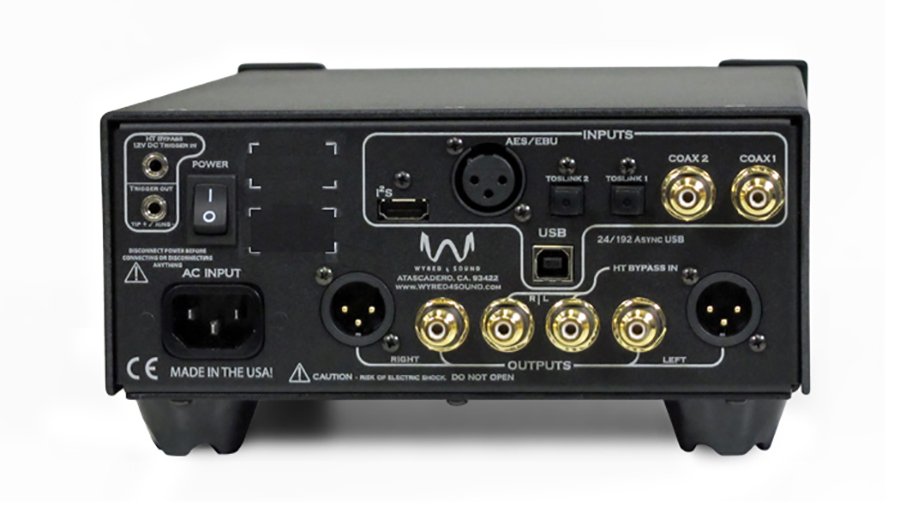
Listening
Turning to USB input I installed the supplied 32bit/DSD driver, with a view to playing audio via Foobar2000. The instruction manual is very good at showing how to do this if you need. It is also good that they supply their own driver, though I would expect this at the price. Playing a 32bit recording of Alan Parsons “Eye in the Sky” with its distinctive and aged electronic drum kit created a very clinical portrayal of the music; basically nothing is added or taken away from the sound, this is as honest a DAC I have ever heard. Turning to the detailed jazz and rhythmic minimalism from the duo of composer Steve Reich and Jazz guitarist Pat Metheny in their joint ‘Electronic Counterpoint’ the music was as coordinated and clear as I have heard this music. Both pride themselves on precision of timing and the W4S DAC made that even more exciting. The Pat Metheny produce excellently recorded albums with clear instrumentation, particularly from the drums, and this was a great listen, though I did miss some of that bass energy or mid warmth that some lesser conversions might present; This DAC is all about accuracy and honesty.
Turning to digital output from my X5 the latest 24/192 binaural album from Chasing the Dragon “Espana – A tribute to Spain” gave me a good chance to hear the clarity and space of sound offered by the W4S. Whilst binaural really works best on headphones, the depth of sound and positioning through loudspeakers is quite astounding. Rosie Middleton’s vocals of Bizet’s ‘Habanera’ and ‘The Gypsy Song’ from the opera ‘Carmen’ were picked up clearly by the KU-100 binaural mannequin from Neumann and presented confidently by the W4S. The close violins and cello’s appeared as if I were sitting on the front row, and the reverb from the Air Studio’s hall was allowed to work its charm with a clarity and finesse that made the music come to life. The slightly late tambourine and triangle entries a few times in Chabrier’s Espana just assisted in making this recording as live a performance as I could get in my living room. The national Symphony Orchestra under conductor Debbie Wiseman performed with passion and this DAC allowed that all to be clear and precise. Bass was deep and top end pin sharp. Listening to my favourite Sibelius symphony No2 (Berliner Philharmoniker, Sir Simon Rattle), the sound gave slightly more grainy violins and more controlled dynamics than I had heard before which slightly disappointed it for me; it was getting all the detail it could out of the recording but this was like lean-beef rather than a full-fat quarter pounder with fries; the former might be better for me, but not quite so enjoyable. The Lake Poets’ ‘Live from The Minster’ gig in Sunderland on 26th September 2015 (24/96 download from Bowers and Wilkins) was a very atmospheric performance with pin sharp accurate reproduction of man and his guitar and audience. Nothing gets past this DAC; it was like watching a film on a 4K television rather than a 1080p plasma.
Turning to jazz the Modern Jazz Quartet “Blues on Bach”, originally recorded in 1973 but available on 24/192 the close harpsichord mic’ing of John Lewis’s playing gave for a very detailed and polished performance in ‘Regret’, especially with the vibraphone playing of Milt Jackson. The slight over peaking in the recording of ‘Blues in B Flat’ did give me a surprise as I hadn’t noticed that one before. “Rise Up in the Morning” is a tune Kenny Everett used in his mime-artist comedy routines, and this gave a chance again for these artists to give a polished performance of harpsichord, vibraphone, double bass and drums including sleigh bells and triangles. To be honest the ESS DAC plus all other components in this box gave as polished a performance as the musicians. A good test when reviewing is to play bad quality recordings to see if they sound any better. If the product is good it shouldn’t actually make the music sound better, if anything it should show up even more of the faults. Ray Davies’s distinctive voice in title track from his album Working Men’s Club gave me a chance to hear the close drum mic’ing, distant backing vocals (including occasional lower octave interjection) and piano and organ and guitars that really aren’t as well recorded and clear as I would wish if I was engineering the album myself. The DAC gave me a chance to see how ordered all the bits could be “assembled” to make my listening experience more enjoyable. If anything, the clarity from the 2v2 made it more painful than the last time I played it. Luckily the next track “Morphine Song” gave me less pain and made me happier, as I would expect the drug itself to do. The guitar was clearer though the thick textures and compression made it less musical. The W4S DAC wasn’t the problem; it gave an excellent top end clarity and a weight through all the frequencies that made the music exciting and clear plus musical all at the same time. I think you get the picture that it is hard to fault the DAC.
Turning to ELO’s ‘Alone in the Universe’, comparing my Krell CD player against the W4S, whilst the latter gave a clearer representation of the vast soundstage I felt the sound was more exciting and real for me through the KPS20i. That player’s aged DAC might not be as clever as today’s wonders but it excited me every time I played. Sometimes perfection misses out some of the magic. The bandwidth/IIR settings can be changed to allow roll-off at above 50, 60 or 70kHz for fine tuning to your personal taste, though, and using the balanced output direct to my power-amplifier gave improved soundstage and musicality, showing the unit can be successfully used in a digital-only system as a very capable preamplifier, if only that remote could excite me more.
Conclusion
This is quite some unit which I actually found hard to criticise apart from the remote. If you want pin-sharp accuracy and speed of reproduction then you cannot go wrong. This machine worked well whatever I plugged into it whether wav, FLAC or DSD. It has an honesty that might surprise you about some of your own digital collection of music. If you can put up with hearing more of the detail and speed, and perhaps hear some of the imperfections in the recordings, then you cannot go wrong. This is one of the best DACs I have listened to, and that ESS Sabre DAC is only part of the story. Wyred 4 Sound really do know how to put all the ingredients together to make a good DAC.
Build Quality: Excellent construction with distinctive ‘two-tone’ design and excellent components and connections. Just let down by a basic remote
Sound Quality: Giving a detailed and honest conversion of the digits fed into it, with a punchy bass and clear top end.
Value For Moeny: At £2299 this might be in upper DAC territory but it is such a good performer, catering for all main digital formats and input terminations. I really enjoyed playing with it. If you use it as a preamplifier then it is even better value.
FOMO. Fear of Missing Out. It’s a rather interesting phenomenon that’s probably always existed, but didn’t become part of the lexicon until fairly recently. Blame our increasingly social world. With more opportunities than ever to connect, one can easily find oneself overwhelmed with options – and paralyzed by the thought of not making the best possible choice.
FOMO certainly exists in the world of audio enthusiasts. Head over to Audiogon and marvel at the quantity of new and used gear up for grabs. I’m not just talking about total count of items for sale, but also the abundance of different brands. There are hundreds of firms represented, large and small, many of whom offer at least a few different models. And that’s just Audiogon – merely one outlet among many. The mind boggles!
How can one possibly hope to evaluate each and every option before making a purchase? And how does one find confidence in the final choice? With such a staggering amount of contenders, it would easy to settle for “good” while overlooking “great”. Or at least to think you may have done so. That’s FOMO in action, and it’s been greasing the wheels of audio classifieds and high street hifi stores for decades.
It’s important to differentiate this feeling from plain old fashioned gear lust. Buying a PS Audio Stellar DAC whilst wishing I could afford their far-more-expensive DirectStream is a whole different matter. FOMO would apply if I buy the Stellar DAC, love what I hear, yet find myself agonizing over potential missed opportunities. “Maybe something else in that price bracket would have been even better”, I think to myself, drowning out the beautiful music being made by my new component. This ultimately diminishes my enjoyment of the device in question, and for that matter, every future device I may ever own.
 This leads me to my review of the new Wyred 4 Sound DAC-2v2SE 10th Anniversary Limited Edition. That name is a mouthful, but the concept is quite simple – start with the highly-respected Wyred 4 Sound DAC platform and go crazy with upgrades. Leave no stone unturned in the quest for extreme performance. The final product will sound so darn good that FOMO just won’t get a look in.
This leads me to my review of the new Wyred 4 Sound DAC-2v2SE 10th Anniversary Limited Edition. That name is a mouthful, but the concept is quite simple – start with the highly-respected Wyred 4 Sound DAC platform and go crazy with upgrades. Leave no stone unturned in the quest for extreme performance. The final product will sound so darn good that FOMO just won’t get a look in.
From where I sit, designer EJ Sarmento totally nailed that goal. What better way to mark a tenth birthday?
Wyred 4 Sound DACs have been making sweet music for quite some time. Roughly eight years ago, their DAC-1 and DAC-2 were among the first offerings to sport the ES9018 D/A chip – flagship of the then-new Sabre line from ESS Technology. Back then, our editor gave the DAC-2 a spin and declared its sonics “colourful but uncoloured”. Many years and numerous iterations later, the series culminates in the special 10th Anniversary Limited Edition – about those same words remain surprisingly apt.
From the outside, the 10th Anniversary DAC looks familiar yet distinguished. The chassis remains structurally unchanged, but the champagne silver finish and commemorative graphics set it apart from lesser models. It also gets fancy lathed aluminum footers which I find quite fetching, and a red display which better matches the overall theme. The silver finish is very obviously a premium touch – it looks like something you’d find on an exotic car – but this still isn’t the most flashy DAC ever to grace my audio rack. That’s not necessarily a bad thing either; the US$4499 asking price is relatively low in the world of top-level DACs, and I’d rather see that budget allocated where it matters most.
Wyred 4 Sound calls this their “most advanced, best sounding DAC ever”. How did founder / lead engineer EJ Sarmento and co. and get there? Since this 10th Anniversary DAC builds on the existing platform, let’s start our discussion there and work our way up.
Highlights of the standard DAC-2v2 include the new ESS Sabre 9028 Pro DAC chip, a fully balanced design, proprietary discrete output stages, galvanic isolation, and a quality USB implementation capable of PCM up to 32-bit/384KHz PCM and DSD256. The overbuilt power supply sports a rather large toroidal transformer and 88,000uF worth of filtering from the W4S low-ESR super-cap. That’s a well-rounded package for the US$2299 asking price.
Stepping up to the DAC-2v2 SE brings a swap from 9028Pro to the flagship 9038Pro. The Femto clock, a $125 upgrade option for the base model, comes standard here. Custom Vishay Z-foil resistors, premium inductors, ultra-fast recovery Schottkey diodes, and Wyred’s proprietary ultra-low noise discrete regulators are all part of the package. Wyred claims these upgrade bring performance to a significantly higher level – as they should considering the price bump of US$1500.
Aside from the previously mentioned aesthetic upgrades, going all-out for the 10th Anniversary Limited Edition doesn’t bring a massive laundry list of additional features. Rather, it hinges on a smaller collection of significant tweaks and optimizations, making it tougher on the marketing folks to brag about, yet very beneficial for end users.
Sarmento explains: “The boards are totally redesigned with new parts and better routing techniques. Everything from power regulators, caps, output transistors, and USB interface were changed. The USB interface is a newer design with optimized galvanic isolation from the previous gen. The new version does the clocking on the DAC side of the isolation for improved signal integrity.”
Next comes the meticulous hand-matching of all components – a tedious process considering the plethora of discrete parts employed in the device. This, plus the various upgrades mentioned by Sarmento above, allows Wyred to squeeze every last ounce of performance out of their existing design. Nearly ten years of digital adventures come to fruition here – the best DAC Wyred knows how to make in the here and now.
 Before discussing sound, I have to mention the fact that Wyred 4 Sound offers something few competitors bother with these days: an upgrade plan. If you’ve got a prior model from Wyred, it can be brought up to current specs for a reasonable fee. This appears to extend all the way back to the original DAC-1. The 10th Anniversary DAC works a bit differently – Wyred call it a trade-up scheme where the majority of earlier DACs retain 70% of their original purchase price. That seems to me an extremely favorable option, outpacing the usual fifty percent trade-in deals found on the second hand market. I would love to see this become a common practice in the ever-evolving world of digital conversion.
Before discussing sound, I have to mention the fact that Wyred 4 Sound offers something few competitors bother with these days: an upgrade plan. If you’ve got a prior model from Wyred, it can be brought up to current specs for a reasonable fee. This appears to extend all the way back to the original DAC-1. The 10th Anniversary DAC works a bit differently – Wyred call it a trade-up scheme where the majority of earlier DACs retain 70% of their original purchase price. That seems to me an extremely favorable option, outpacing the usual fifty percent trade-in deals found on the second hand market. I would love to see this become a common practice in the ever-evolving world of digital conversion.
The 10th Anniversary DAC faced a tough challenge right off the bat. It slotted into my system in place of the COS Engineering D1, a beast of a DAC whose US$9000 asking price – double that of the Wyred unit – puts it up there with the likes of Bricasti Design, Meitner, and some of the entry-level designs from Esoteric. Surely even the overachieving Anniversary DAC doesn’t quite belong in that elite company…or does it?
The system was assembled with some of my most resolving gear (which doesn’t necessarily mean my most expensive gear). An Equi=Core 1800 balanced power conditioner anchored everything with clean power, whilst the Euphony PTS music server (running Roon, of course) fed by a Wyred 4 Sound PS-1 modular power supply, plus a Wyred 4 Sound Recovery (also powered by the PS-1) made up the front-end. The Anniversary DAC sent a balanced signal out to the Violectric V281 headphone amplifier, initially driving a modified/balanced Sennheiser HD800 but with numerous other headphones in the queue. Cabling was a mix of Cabledyne Silver Reference and Better Cables Blue Truth II. Again, not the most expensive equipment out there, or even the most expensive I own, but nonetheless highly revealing of DAC differences both large or small.
Stepping down from COS to Wyred resulted in a fairly notable change in presentation quality but perhaps not in the way one might think. This was actually an improvement – and a significant one at that. Tonal density took an immediate turn for the better, imparting a proper sense of “chugging” to my metal collection. The D1 played it more politely – appropriate for something like Black Label Society’s unplugged album The Song Remains Not the Same, but not so much for their usual heavier fare. I wouldn’t necessarily call the D1 thin per se, though in comparison to the Anniversary DAC a certain lack of body and grunt could be called out.
The Wyred DAC also produced a more startling snare drum SNAP! on Steve Miller Band’s classic “Take the Money and Run”, and handled Minor Tapes by Electronic Noise Controller with clearly superior drive, texture, and impact. The D1 seemed more at home playing Amber Rubarth and similar wispy singer/songwriter material, portraying vocal sweetness and transient decay very convincingly. To be fair, the Wyred DAC also performed superbly with that sort of “audiophile” stuff, teasing out more body and resonance from acoustic guitars whilst also showing top end delicacy with aplomb. In short, the COS Engineering D1 made beautiful, somewhat polite music which worked better on some genres than others. Despite the massive price discrepancy, it was simply outclassed by the more affordable Californian counterpart, whose sonic prowess showed considerably greater genre independence.
 Was this some anomaly? Is the COS Engineering DAC just a dud, thus making the Wyred Anniversary DAC look better than it otherwise would? Not at all. Wyred 4 Sound really has built something capable of standing toe to toe with digital heavies yet costing significantly less. In a world where new flagships tend to push the cost ceiling ever higher, that’s something to be excited about.
Was this some anomaly? Is the COS Engineering DAC just a dud, thus making the Wyred Anniversary DAC look better than it otherwise would? Not at all. Wyred 4 Sound really has built something capable of standing toe to toe with digital heavies yet costing significantly less. In a world where new flagships tend to push the cost ceiling ever higher, that’s something to be excited about.
The Anniversary DAC has a wonderfully palpable tone, particularly in the presence region, which helps balance out potentially clinical systems or recordings. I switched around my gear to build a deliberately lean setup, starting with a long-in-the-tooth OPPO DV-983H (dragged out of storage). Spinner lashed to DAC via TOSLINK which tends to be the least impressive interface. Rupert Neve’s brutally honest RNHP headphone amplifier, as good as it is (review forthcoming), promised to deliver “just the facts” with no hint of added warmth, while a trio of somewhat lean sounding headphones rounded out the system – the Enigmacoustics Dharma, MrSpeakers Ether, and (unmodified) Sennheiser HD800.
While the Wyred Anniversary DAC did not transform these relative lightweights into smooth operators a la the comparatively warm/dark Audioquest Nighthawk, it nonetheless helped firm things up in an otherwise washed-out system. From more eclectic acts like DAT Politics and Nils Petter Molvaer to straight-ahead rock from The Mother Hips or Beardfish, the result was full-bodied, fun, and surprisingly non-fatiguing. Vocals, potentially glassy and grating on these headphones, instead gave a well controlled, authoritative tone, in the end being undeniably listenable with the Wyred DAC in place. Swapping in alternate D/A converters from Benchmark, Mytek, Chord, or Grace Design robbed music of this pivotal quality.
 Lest you think the Anniversary DAC is yet another member of the “rose-tinted-glasses” school of DAC design, I have to clarify how resolving and transparent it really is. The warmth, body, and fluidity I’ve spoken about comes not at the expense of accuracy, as seen in many otherwise enjoyable designs; see Metrum’s early models, or any number of tube-equipped NOS DACs to get my drift. Better examples in that camp aren’t merely rolled-off but instead favor a relaxed presentation when it comes to transient attack or leading-edge snap. Again, Wyred’s crown jewel doesn’t fall into that trap – I want explosively-dynamic drums and brilliantly-biting trumpets, just as those instruments play in real life, and that’s exactly what I get with the Anniversary DAC. It possesses a brilliant resolving ability, particularly with respect to top-end purity and air. Very rarely have I heard such beautiful finesse from the voices of Marta Gomez or Rachel Z – there’s certainly no blunting of the high-end to be found here. But neither is there an artificial sense of “detail” we often hear from DAC makers trying to out-resolve one another. The Wyred 4 Sound Anniversary DAC, to my ears at least, hits the balance just about perfectly.
Lest you think the Anniversary DAC is yet another member of the “rose-tinted-glasses” school of DAC design, I have to clarify how resolving and transparent it really is. The warmth, body, and fluidity I’ve spoken about comes not at the expense of accuracy, as seen in many otherwise enjoyable designs; see Metrum’s early models, or any number of tube-equipped NOS DACs to get my drift. Better examples in that camp aren’t merely rolled-off but instead favor a relaxed presentation when it comes to transient attack or leading-edge snap. Again, Wyred’s crown jewel doesn’t fall into that trap – I want explosively-dynamic drums and brilliantly-biting trumpets, just as those instruments play in real life, and that’s exactly what I get with the Anniversary DAC. It possesses a brilliant resolving ability, particularly with respect to top-end purity and air. Very rarely have I heard such beautiful finesse from the voices of Marta Gomez or Rachel Z – there’s certainly no blunting of the high-end to be found here. But neither is there an artificial sense of “detail” we often hear from DAC makers trying to out-resolve one another. The Wyred 4 Sound Anniversary DAC, to my ears at least, hits the balance just about perfectly.
Whilst maintaining a very high standard across the board, Wyred does give us several ways to tweak the DAC for individual flavor; starting with your choice of multiple digital filters for subtle fine tuning. Night and day differences? Nope, but a bit more noticeable than I’ve experienced with other DACs. The default setting – Apodizing fast roll-off linear phase – is probably the most universally appealing choice, but I also quite enjoy Slow roll-off minimum phase and Hybrid fast roll-off minimum phase.
These bring to mind the film simulation modes on Fuji’s excellent mirrorless cameras. Provia nets the most technically accurate results, making for a sensible default setting. Velvia makes for more vivid shots, with increased saturation for a more dynamic look. Classic Chrome switches to a smoother character with enhanced contrast. None of these transform a wedding “fauxtographer” into Yousef Karsh, but they do offer a welcome change in flavor when used in the right context.
Next comes the variable jitter reduction function – a rare option amongst digital processors. Users can choose between 8 stages of jitter reduction from the ESS Sabre chip, or disable it altogether. The Anniversary DAC thus accommodates everything from poor quality transports to reference rigs and everything in between – tailoring the jitter processing to ideal levels in every case. I find that turning it up to max really helps clear up imaging and spacial cues when using a basic laptop as transport. On the flip side, using a high-quality transport like my Euphony PTS or the overachieving Cayin iDAP-6 allows jitter reduction to be deactivated completely. This brings improved layering and superior timbre to the presentation. Other sources, like my SimAudio and OPPO disc spinners, sound best with the setting somewhere in the middle. Between this option and the digital filter selections, there’s quite a bit of mix ‘n match action to be had. Again, you won’t transform the Anniversary DAC into an entirely different animal, but you can emphasize certain aspects of its character should you wish.
 As for inputs, I find them universally excellent with one exception: the I2S input is by far the pick of the bunch. Use it – do not hesitate. I2S over HDMI is not a universal standard, so there’s no guarantee of compatibility with every device. Thankfully Wyred 4 Sound saw fit to use the same pin format as PS Audio, making it compatible with their PerfectWave and DirectStream transports. For those who no longer bother with physical media, the previously mentioned Cayin iDAP-6 is a winner at US$799. Or, for just US$379, the Matrix Audio X-SPDIF 2 will convert any USB output to an I2S signal the Wyred can work with. Again, it’s quite clear from my testing that I2S is what you want to shoot for. All other inputs sound quite good, but once you hear I2S you won’t want to regress.
As for inputs, I find them universally excellent with one exception: the I2S input is by far the pick of the bunch. Use it – do not hesitate. I2S over HDMI is not a universal standard, so there’s no guarantee of compatibility with every device. Thankfully Wyred 4 Sound saw fit to use the same pin format as PS Audio, making it compatible with their PerfectWave and DirectStream transports. For those who no longer bother with physical media, the previously mentioned Cayin iDAP-6 is a winner at US$799. Or, for just US$379, the Matrix Audio X-SPDIF 2 will convert any USB output to an I2S signal the Wyred can work with. Again, it’s quite clear from my testing that I2S is what you want to shoot for. All other inputs sound quite good, but once you hear I2S you won’t want to regress.
Comparisons become tough when something performs at this level. In my mind it simply outclasses favorites like the Resonessence Labs Veritas, PS Audio DirectStream, and B.M.C. UltraDAC. But it’s not as simple as “better bass” or “more resolution”. The B.M.C. comes closest in terms of signature, yet Wyred 4 Sound takes things a step farther by sounding – for lack of a better word – more analog. I fully realize that word means different things to different people… for this listener, it describes a lack of stereotypically digital sound. There’s a sense of ease, tonal weight, and liquidity which many (most?) DACs miss out on to some degree. The B.M.C. UltraDAC does a fine job already – it’s among the best I’ve ever heard – but the Anniversary DAC is even better. No small accomplishment considering both units fall well-short of the upper-end on DAC pricing.
 Unfortunately, I can’t fully compare the Anniversary DAC to my reference, the Resonnesence Labs Invicta Mirus Pro because of its recent departure to be upgraded to Signature status – whilst in the middle of evaluating the Wyred DAC – and have not had enough time to fully flesh-out the consequences. I suspect the Resonessence Labs unit may ultimately remain my reference, but it’s not a slam dunk by any means. The Mirus Pro Signature version sells for nearly double that of the Anniversary DAC, so the two don’t necessarily compete directly in the first place. Thus far I can make this (flawed) analogy: the Resonessence unit is more like a top Stax electrostatic earspeaker, while the Wyred Anniversary DAC is closer to the best Audeze planar magnetic headphones. Both make exquisite music yet focus on somewhat different areas. Choosing a winner really comes down to individual preference and system matching more than any inherent superiority. That’s about as far as I’m prepared to go until I get many more hours of listening under my belt.
Unfortunately, I can’t fully compare the Anniversary DAC to my reference, the Resonnesence Labs Invicta Mirus Pro because of its recent departure to be upgraded to Signature status – whilst in the middle of evaluating the Wyred DAC – and have not had enough time to fully flesh-out the consequences. I suspect the Resonessence Labs unit may ultimately remain my reference, but it’s not a slam dunk by any means. The Mirus Pro Signature version sells for nearly double that of the Anniversary DAC, so the two don’t necessarily compete directly in the first place. Thus far I can make this (flawed) analogy: the Resonessence unit is more like a top Stax electrostatic earspeaker, while the Wyred Anniversary DAC is closer to the best Audeze planar magnetic headphones. Both make exquisite music yet focus on somewhat different areas. Choosing a winner really comes down to individual preference and system matching more than any inherent superiority. That’s about as far as I’m prepared to go until I get many more hours of listening under my belt.
Wrapping things up: Tone. Body. Organic warmth without sacrificing resolution. Stunning imaging and speed. This is the 10th Anniversary Limited Edition DAC from Wyred 4 Sound. It’s just a superb performer, showcasing the full potential of EJ Sarmento’s DAC platform. I would – and did – happily put this sub-$5k thoroughbred up against all manner of more expensive competition. Ultimately I can say this DAC has challenged my view of what can be accomplished for less than five grand – spending more doesn’t tend to achieve tangible benefits, and in most cases I’d choose the Wyred option hands down. It’s that good.
Description
DAC-2v2 Features
-
ESS Sabre 9028PRO 32 bit DAC chip
-
W4S proprietary discrete output stages for optimum sonics
-
ESS Time Domain Jitter Eliminator®
-
Automatic oversampling for precise output filtering
-
Asynchronous USB input and balanced I²S input support up to 32-bit 384kHz PCM and up to DSD256
- Improved audio quality through USB input
- USB 2.0 compliancy & ASIO 2.2 (Drivers support for Mac and Linux systems)
- Galvanic isolation
-
Fully balanced design with balanced and unbalanced outputs
-
Upgradable Digital, Output, and USB boards (designed for future improvements)
-
Oversized toroidal transformer for solid and noise-free power
-
88,000uF of filtering with W4S low ESR “super-cap” (same as used in the STP-SE)
-
VFD display for input, sample rate, volume control, and configuration viewing
-
Remote control
-
Defeatable 32 bit volume control
-
HT Bypass inputs (selectable via DC trigger)
-
2x Coax inputs
-
2x Toslink inputs
-
1x AES/EBU input
-
1x Balanced I2S input via HDMI cable (note: not standard HDMI cable format)
- Proprietary drivers for Windows (no drivers needed for Mac or Linux)
-
Factory selectable mains 115/230VAC
-
Compact size (8.5″W x 4.125″H x 13.5″D)
-
14 lbs.
-
Covered by a 5 YEAR WARRANTY
DAC-2v2 SE (adds the following to the DAC-2v2):
- ESS Sabre 9038PRO 32 bit DAC chip
- Custom Vishay Z-Foil resistors (0.1% tolerance and a +/-0.5ppm/°C)
- Femto Grade Clock (82 fSec phase jitter)
- Ultra-low noise discrete regulators (100+ times quieter and faster than the stock regulator)
- Ultra-fast recovery Schottkey diodes
- Premium grade inductors
- Upgraded fuse
- Green OLED display for input, sample rate, volume control, and configuration viewing
Please be aware: Due to the expensive specialty parts as well as the extensive labor involved, DAC-2v2 SE orders are non-refundable.
DAC-2v2 and 2v2SE Specs:
- Typical Distortion THD+N (20-20kHz A-weighted @ Vol. 55): <0.002% THD+N
- Frequency Response (20-20kHz): ± 0.065db
- S/N Ratio: > 120 db
- Crosstalk: > 125 db
- Noise (A-weighted): < 7uV
- Noise: < 9uV
- Balanced Output Level (Vol. 100%): 10.5V (20.1 db)
- Unbalanced Output Level (Vol. 100%): 5.2V (14.5 db)
- Output Impedance: DAC-2v2: 100Ω, DAC-2v2SE: 50Ω
- Channel Tracking: < ± 0.50 db
- Dimensions: 8.5″W x 4.125″H x 13.5″D
- Weight: 14 lbs.
